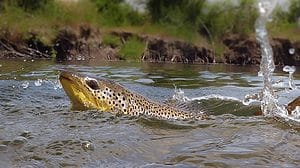Disclosure: Some posts contain affiliate links, which earn us a commission if you make a purchase through them. Positive Fishing © participates in various affiliate networks including the Amazon Services LLC Associates Program.
As you grow your angling skills, the rod and reel setup details matter more. At one point, you may have picked the cheapest fishing line you could find, attached it to your reel, tied it to your hook, and not even thought twice about it!
However, as anglers gain more experience, it’s obvious that things like the fishing line are a crucial factor when fishing, in both the quality and the size of the fish you try to catch.
In this article, I will show a fishing line diameter chart based on the average top brands of lines and provide some useful information on how this affects whether you should use the best braid, monofilament, or fluorocarbon line.
| Line Test* | Monofilament Diameter | Fluorocarbon Diameter | Braided Line Diameter |
| 2LB | .005in | .005in | .004in |
| 4LB | .008in | .007in | .006in |
| 6LB | .009in | .009in | .005in |
| 8LB | .010in | .010in | .007in |
| 10LB | .011in | .011in | .008in |
| 12LB | .013in | .012in | .009in |
| 14LB | .014in | .013in | .009in |
| 17LB | .015in | .015in | .010in |
| 20LB | .016in | .016in | .010in |
| 30LB | .020in | .020in | .012in |
| 40LB | .024in | .022in | .013in |
| 50LB | .028in | .029in# | .014in |
| 60LB | .030in | .032in# | .015in |
- The chart shows an average comparison of multiple manufacturers
- * Line test is also known as the breaking strain
- # Note that fluoro over 50lb is slightly larger in dia than mono
Why Is Fishing Line Diameter Important?

Fish are picky! If your line is too thick or is the wrong material, you may catch half the fish you should have.
You can use the wrong line type, meaning the fish won’t bite. Or, you may likely have used the perfect line type, but the test is wrong.
What Is The Impact Of Using The Wrong Line Test?
- Using too thick a line will likely shy away fish from your bait.
- Using too thin a line can break when landing a large fish
Either way, it’s important to have a strong understanding of all fishing lines. Besides your bait, it’s the most important part of an angler’s fishing tackle! Especially if you want to catch more fish and bigger fish!
Comparing Fishing Line Diameter
The general rule is that braid is almost always thinner than both mono and fluorocarbon lines for the same strength test.
Fluoro and mono are very similar in their diameters versus their strength. You may find that most manufacturers of fluoro have around 5% – 10% less diameter than a mono line.
What Are The Advantages Of Thin Fishing Lines?
- The major difference (as we mentioned earlier) is that the fish will have less chance of seeing a thinner line than a thicker line, which will create more bites and takes on your bait.
- Another benefit is that you can spool far more line on a reel with a lower diameter line. Therefore braid (being a lower diameter) will allow you to fill at least 30% more line on your reel.
- Using thinner lines when fishing during the colder months will get you more bites. The fish become warier and will eat only the best-presented baits.
- Your bait or lures will flow more naturally in the water.
- Finally, it is always easier to cast further distances with thinner lines.
Final Thoughts
If you have read several of my articles on fishing lines, you will know by now that there are many important aspects to understand in three main types of fishing line.
Other than cost, knot strength, stretch/memory, abrasion/shock resistance, etc., its line diameter is most forgotten.
I hope this informative article was interesting and helped you understand the effects of line diameters and strength. Please check out my comparison of braid, mono, and fluoro lines, which outlines the benefits and negatives of each type in detail.
- Wading Belt Essentials: Ensuring Safer Fishing - January 9, 2024
- Fishing For Catfish (Top Tips, Bait, & Gear To Catch The Big 3) - October 20, 2022
- Fishing Line Strength Vs. Diameter Chart: Why Is It Important? - October 12, 2022

